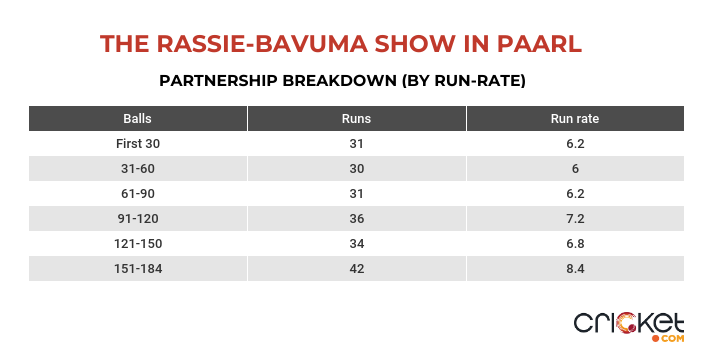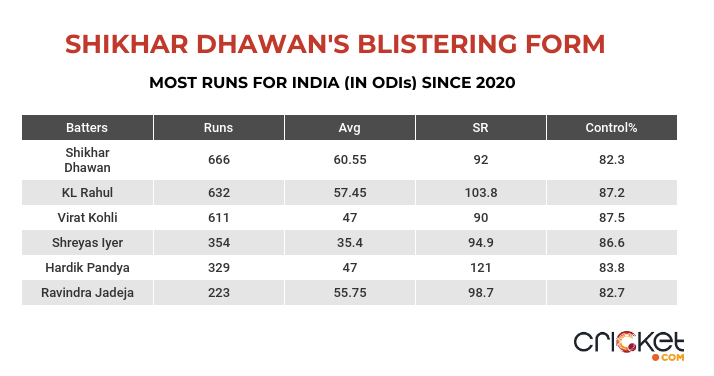 TALKING POINTS
TALKING POINTSBavuma-der Dussen and the perfect ODI template
Two batters with averages of 49.90 and 65.56 but a situation of trouble, at 68/3 after 17.4 overs, everything was stacked against Temba Bavuma and Rassie van der Dussen. The biggest part of South Africa’s white-ball success has been the duo and when they walked out, there was no panic.
204 runs, 184 balls, twin centuries later, South Africa were in a commanding position and the two hours of madness made it possible. Van der Dussen’s approach was rather clear, he was the aggressor and Bavuma, the long-haul player. The Proteas No.5 didn’t back away from the challenge.

“Learnings I have taken in the last year or two is if you have your plans and you've done the preparation, need to back yourself to execute whether it's the first ball or the 100th ball," Rassie said post his innings at Paarl.
"Stuff like the reverse-sweeps and sweeps - In the past I might've taken 15-20 balls, but today I decided .. the conditions told me to take it early on,” he added.
Prior to this clash, the pair had one century-run partnership in between them. Rassie, in particular, showed excellent control, with 70% control in the first 40 balls. Post that, he went ballistic. In the 56 deliveries post that, he scored at a strike-rate of 154.44, and had a false-shot percentage of 5.25.
There is a reason why Rassie averages 65.56 in the ODI format and his century on Wednesday was yet another exhibition of why he is hailed in the white-ball formats.
KL Rahul’s bizarre tactics with bowlers
At the innings break, South African batter van der Dussen expressed that they were ’70 above par’ and that showed the chinks in KL Rahul’s armor. Rahul’s tactics as India’s skipper was bizarre and there were several instances of that throughout the first innings. In the pre-match press conference for the first ODI, the 29-year-old, opined the importance of having a sixth bowler in the form of Venkatesh Iyer.
On Wednesday, one would have expected the all-rounder to have some sort of say on the game but that was far from reality. Only five bowlers were used and bizarrely, Rahul did not even bring on Iyer during the 30-40 overs phase. Instead, he opted to bring his frontline bowlers – Jasprit Bumrah and Bhuvneshwar Kumar – leaving him in dire straits at the death, to trust Shardul.
Even when the bowlers were under the pump, there were no instances of the Indian skipper having a word with the bowlers, with a field that gave plenty of room for South Africa to attack. In 11 ODIs out of his last 12, Thakur conceded at an ER of above six. Despite that, the insistence to bowl him at the death was a costly mistake.
Not to forget the absence of Mohammed Siraj, in a format where India have struggled with the ball.
Shikhar Dhawan is indispensable in ODIs
Heading into the 2023 ODI World Cup, there is already a long discussion over Shikhar Dhawan’s place in the lineup. A left-handed opener? One who has multiple gears? One who takes responsibilities? Dhawan ticks all that box and more with his consistency for the national team. Since 2020, in the 50-over format, no Indian player has scored more runs than Dhawan, showing his importance for the Men in Blue.

The 36-year-old has that unique ability to keep ticking the scoring rate while not taking any risks, which still makes him an integral part of the Indian setup, in the ODI format. His consistency at the top of the order is unparalleled in world cricket, with an average (65.1) only below Janneman Malan (74.11).
While he might not have any centuries against his name in the last two years, his balls/boundary is only behind the English pair of Jason Roy and Jonny Bairstow, taking adequate risks. With ODI being a format where there is a real need for maintaining a left-right combination, Dhawan’s presence is certain for India.
Should Pant be a certainty in India’s ODI plans?
South Africa found themselves at 68/3 and India, 138/1, Guess which of these sides collapsed to 188/6? India! While most certainly all of the blame can’t be on Rishabh Pant, his performance in the 50-over format hasn’t been the most convincing. In 16 innings, the southpaw has crossed 50 only thrice, with an average of 33.06. While his strike-rate (114.25) is certainly tempting, there is really a case for him not be a certainty in India’s ODI plans.
While it may be confusing to understand it in the first instance, India already possess a wicketkeeper-batter, who can bat in the middle-order (KL Rahul). For India to pick both Rahul and Pant, they will have to let go of either of one option – one less batter or one less bowler.

Not just that, with India seemingly placing their trust in Venkatesh Iyer, and the return of Ravindra Jadeja, there would be a case of too many left-handers in the lower-order, forcing India’s hands. Rahul’s efficiency in the middle-order (56.62) has been well-noted and with Rohit Sharma’s return to the setup, it would only make sense for India to not pick Pant.
Also, Rahul’s ability to have multiple gears with the bat only tilts the selection in his favour, a decision that India would have to take at some point in the future.